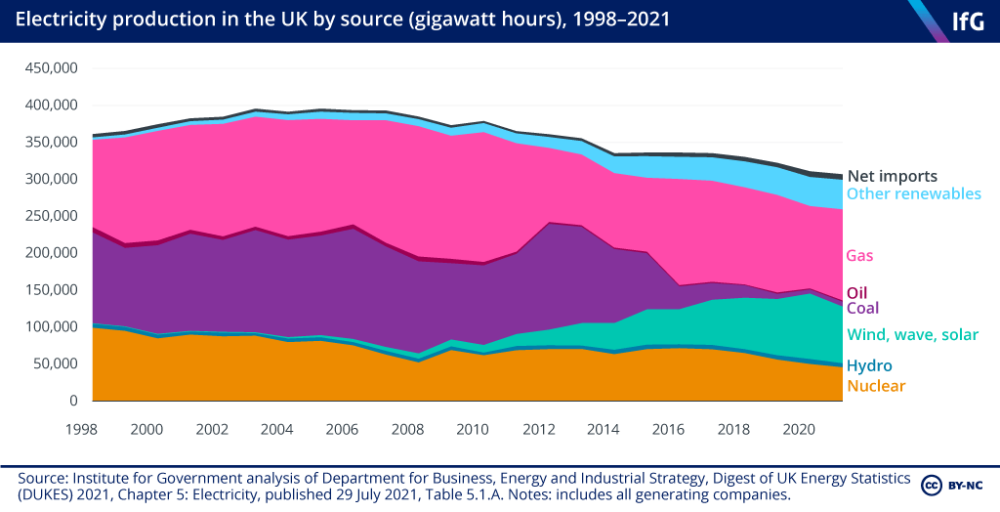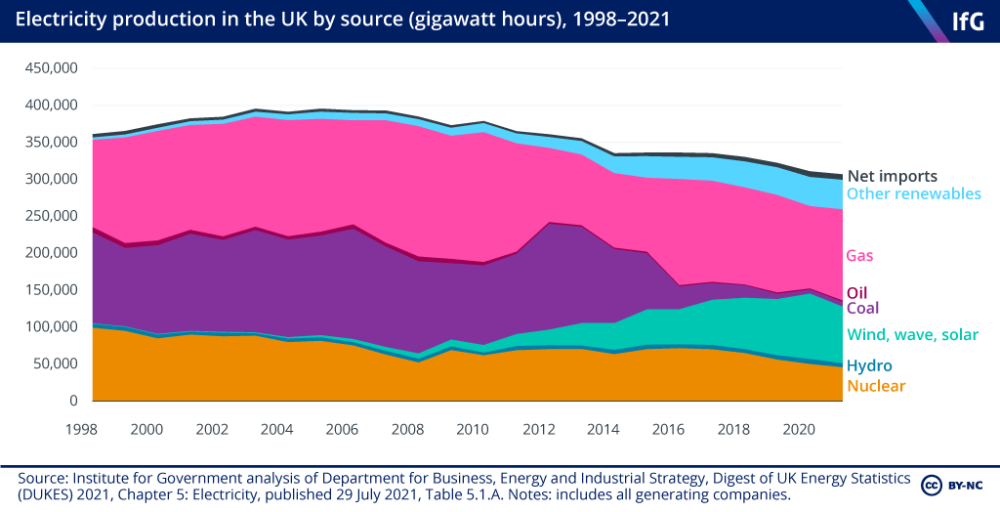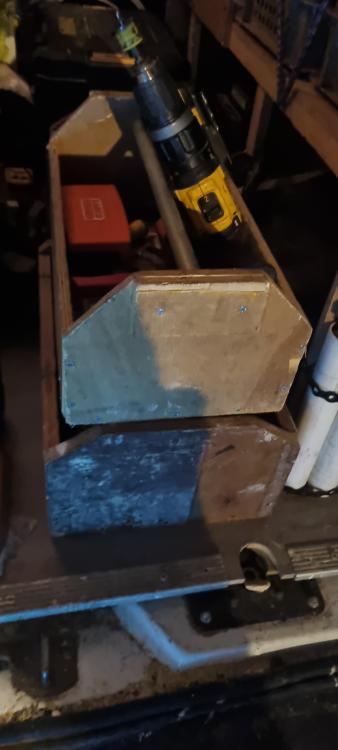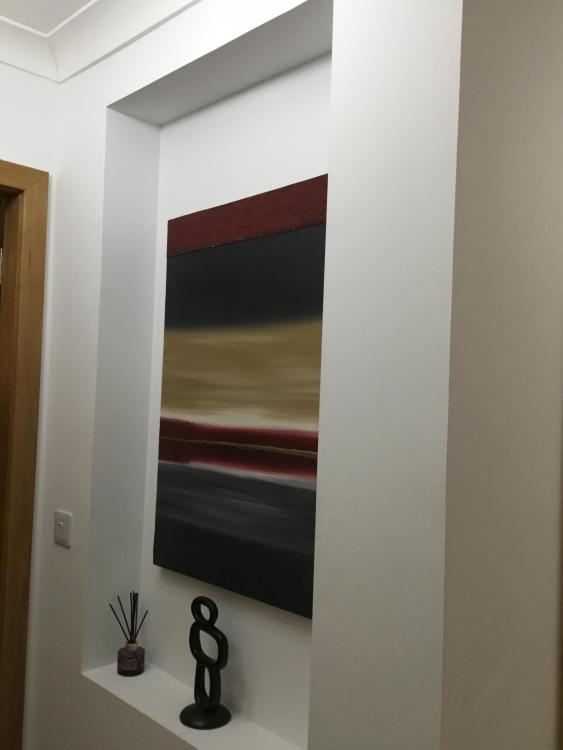Leaderboard
Popular Content
Showing content with the highest reputation on 12/18/23 in all areas
-
If you are a fairly practical person, consider making an air blower that fits in a suitable window. Find out where the leaks are, before you squirt anything into unseen cavities.2 points
-
There seems to be something missing from this discussion. It's all about trying to iron out the peaks and troughs of energy production, all be it in a different way.... We have the same problem at our home, but on a much much smaller scale: Our PV energy production during the year is more than enough to meet our needs.... if only we could store it from the summer until the winter. If we were to go off grid we would need an energy production system that produced our needs over the winter which would be idle over half the year when considering the yearly cycle, and on a immediate basis, to some extent, all year. We could have a much smaller immediate energy production system during peak demand, if peak demand was supplemented because of stored energy. As I understand it, energy produced for the national grid uses systems that, whilst can produce electricity at the flick of a switch, require a long lead in time to be ready to flick the switch. When looking at this graph you can see that the higher fluctuating energy producers - wind wave and solar - are producing an increasing percentage of our energy demands. However they are less reliable in there ability to supply demand. (The one exception being wave which for some mad reason is not being utilised). This means the power has to come from other sources like gas or nuclear. Taking a simplistic view of the situation you could say that the gas and nuclear energy suppliers have to be able to cover the wind and solar supply demand at any moment. Everybody is trying to break the problem of energy demand and energy storage and this is just another spoke in the wheel. About 60% of UK household energy use is for space heating and about 35% of UK's electricity is domestic use.2 points
-
@puntloos I wonder if you’re overthinking this regarding the MVHR aspect. The downdraft recirculating extractor on our hob can boost at up to 570m3/hr though more normally it’s around the 200-300m3/hr. I’ve not once considered its effect on the MVHR which is seldom above 100m3/hr and never noticed any problems. With the extractor on a high setting it starts moving air internally around the house which becomes apparent if we’re cooking something pungent, with the extractor on a high setting and the kitchen door open, the smell will start spreading around the house indicative of all of the air in the house starting to move around heading towards the kitchen extractor. This is not an obvious airflow, only detectable as the smell spreads around. I would expect the same in your situation that with a high ventilation rate to keep your network cupboard cool the air within the house will slowly start recirculating through the cupboard. The MVHR will just get on with its thing, unperturbed.2 points
-
It's because modern washing machines use much less water. If they draw what they need from a hot pipe, that's often not enough for the hot water to actually reach the machine - you're starting with cold anyway, while the hot water in the pipe goes cold.2 points
-
Get together with the neighbours and buy it? Check the planning situation with the council to see if he’s bluffing? Nb Devaluing your property isn’t a proper planning objection2 points
-
For customers I tend to choose load compensating controls over just weather comp, although a few of these now also use weather data from some internet source (which weather data is accessed, I don't know but in my experience it's not far off). Here's a link to a University of Salford test of a variety of controls under different circumstances. If you read paragraph 4.1 you'll see they note some of the set up problems that exist with weather comp. only. https://www.beama.org.uk/static/7f5ebe31-04e1-470e-9befd249359959d9/15d07ed2-35d0-4c9f-90f958f81e9425f6/Salford-tests-on-load-and-weather-compensation.pdf1 point
-
Delete the MVHR extract and surely the problem goes away doesn’t it? If the chimney effect is not sufficient then I would have thought an extractor fan of some description would be sufficient to get the required airflow through the cabinet. I have no maths to back up that theory!1 point
-
If everything was IoT (Internet of Things) it could all be controlled by a remote system. It could even have look ahead capability to get ahead of the weather and be self tuning to the insulation / decrement delay.1 point
-
Do you actually need the space inside the roof area, or could you just board out a ceiling underneath the trusses (9mm osb or shuttering ply would do the trick on the cheap) and then fill on top with loft insulation? Would probably work out cheaper than PIR and you could get more insulation in. You could build in a loft hatch for access etc.1 point
-
I made wooden springs for a camper conversion bed years ago, each was 3” wide 3mm ply strips x5 glued together and clamped to a curved former, worked brilliantly. I recently did a factory tour with my son to the Morgan factory where they still use the same former and clamps over 60 years old to make the rear wheel arch (I can highly recommend visiting the Morgan factory).1 point
-
Sadly, Dave is probably right. Maybe cut a hole somewhere unobtrusive and see if you can detect any air movement behind the plaster board. Especially if its windy. Steamy suggestion is where to start though. Go for the easy wins first.1 point
-
It is sad, yes. However, i dont think we need to worry too much, as we discussed on here before, to get this done by 2030, we need to do 70k installs a week. Which is about what we manage in a year. So the reality is, its going to be a very long time. So some will lean. But ultimately, yes you are correct, many will be paying much more than they should. Indeed, plenty of people with heat pumps already are. I know a couple. To say they are not very happy would be an understatement.1 point
-
Hi, Did you use dpm sheet? I think I need to put down dpm sheet as a vapour barrier or a liquid sealer 🤔 Probably best to fix the battens to concrete as well. Cheers1 point
-
I have battened an uneven floor just using ply packers, find the highest spot, start there and pack everywhere else to get a level. I didn’t use insulation (customer decided against it 🤷♂️) I then laid oak flooring direct to the battens.1 point
-
yep https://www.renewable-technology.com/projects/strangford-lough-tidal-turbine-northern-ireland/ https://en.wikipedia.org/wiki/SeaGen1 point
-
You could perhaps loop some builders band over the rafters and bring down the inside face of the pallets?1 point
-
Looking at gas boiler WC curves they start at 20 degs with an outside temp of 20 degs. So it should be really as simple as take note of outside temp set flow temperature at a reasonable guess, say 35 degs, how much hotter or colder than target temp is the house after 24 hrs, set appropriate curve by reading the supplied chart. All Atag boilers come with WC, they have a simple selection chart, low temp radiator or high radiators or UFH, well insulated etc. and points you towards a starting curve. You can then adjust the whole curve up or down on the controller like you would a thermostat. Should all be pretty basic stuff for an installer.1 point
-
Weather compensation has been mandatory in Germany for many years, which is why many newer gas boilers have it. Presumably German plumbers have found a way either to set it up in one go, return efficiently to tweak it, perhaps on a rota, or teach German house owners how to tweak it. Are we saying that our plumbers are incapable of doing what the Germans do? Presumably also Polish plumbers, who doubtless work just across the border from time to time now they have fled the UK, have also worked out how to do it. Alternatively we can just sacrifice 10-25% in performance. Given that replacing our gas boilers with heat pumps is now an unavoidable necessity, we are either going to have to sort it out or suffer a performance penalty. As it happens I am firmly of the opinion that, at least for homes with smart meters, a bit of AI (or even human intelligence) applied to the half hourly meter readings will both enable us to size heat pumps correctly (unlike the spreadsheet method as it appears to be applied in many cases) and create a weather compensation curve. I find it impossible to believe that Octopus aren't working on this already.1 point
-
Let me tell you why I think the paintball thing is unlikely. if I was wanting to start up a paintballing business I’d want a location that allowed players, ideally lots of them, to play various games that allowed competitors to run around all over a big bit of land. A narrow strip of land would mean that teams couldn’t out flank each other it would just be two teams firing at each other from each end of a narrow strip. Paintballs, especially with wind, can travel quite a distance. A “defending” team of paintballers would just have to locate in a central part of the strip and an attacking team wouldn’t be able to advance. It would be very stagnant and boring stalemate. I’m fairly sure that any planning conditions would require paintballs not to land on yours as a minimum measure. As such that 50m strip would reduced to almost nothing as paintballs can travel quite a distance with wind. Mitigation ? Lots of expensive high planting / fencing? Have a look at nearby paintball activity companies. See what they offer v what that land could offer. I’m pretty sure they will have better land so how could it be commercially viable, especially with an immediate a close neighbour who would understanding object to it. Why would someone want to paintball on a thin bit of land when other companies offer a better experience. How close is the nearest paintball centre. How close are you to areas of population. Would there be lots of parking, places to put in storage facilities, toilets, catering. They wouldn’t want to risk that with a neighbour next door complaining. I think the seller is at it and sounds like he’s being an d£&k. Offering to sell it to a paint balling company is a very different thing to a company seeing it as commercially viable land for that activity and buying it. If he makes that comment again I’d say good, I’ve always fancied taking up paintballing. Then go and do your research on bats, squirrels and various protected wildlife. You can put in measures to encourage habitation and report / record activity. Bats etc have rights you know.1 point
-
1 point
-
1 point
-
Hi @joe90 My guess is electrolysers1 point
-
We really aren’t missing the point. It was fine until something changed. That change was adding a lot of extra weight onto the timbers. If the timbers had some space between them (that weren’t filled with packers say) then they can move. Even very small movements will crack plaster. I went around all my first floor timbers and packed out any narrow gaps with thin bits of wood and glue for example.1 point
-
HI @SteamyTea and @saveasteading https://tethys.pnnl.gov/project-sites/meygen-tidal-energy-project Mygen: To date, the site has two of four turbines fully operational and generated its first 50 GWh of renewable power in February 2023. The project aims to have the additional turbines operating by 2027. Good luck asking for money...1 point
-
What are we looking at, the side of the shed with the roof set at a fall? Only thing I might do is face the "4x2s" or whatever they are with ply, brought flush to the face of the pallets. A birdsmouth I think stops the rafter slipping of the wall plate. Glue some wedges in there maybe then screw down with long screwd?1 point
-
1 point
-
Double chord at the top because the chord in compression is liable to buckle, whereas a single large tension chord won't buckle. These are massive and as you reduce the size the relative cost of fabrication increases. A truss is used because the additional fabrication cost is worth it for the reduced material and weight saving (and some architectural value too). You wouldn't change a 300mm deep beam for a truss because the fabrication cost would many multiples of the cost of the raw steel. Many years ago when steel/iron was costly and labour was dirt cheap, you sometimes found small trusses. But aside from prefabricated things like metal web joists and roof trusses you won't find fabricated steel trusses at a domestic scale.1 point
-
I got our VAT back for our Geberit frames and toilets Gary. In German, VAT is MWSt and probably 19%1 point
-
Not a mad reason it is not utilised. Find a wave machine anywhere that has worked reliably, then ask the manufacturers to pay back my local council who invested heavily in WaveHub.1 point
-
Nope, at very shallow rafter pitch a birdsmouth would do nothing except weaken the timber.1 point
-
Although we have a slab (insulation above) due to being upside down - master bed / en-suite also on FF , 3 bed rooms GF - we’ve gone ASHP and radiators. We are building to Passivhaus Standards and airtightness but due to North facing and views will can only get to approx 14w/m2. (House 207 m2) So we aren’t certifying. radiators running at 35/30 at -4 on a single zone but TRVs in the downstairs bedrooms to enable guests to step down if required. No radiator in Master Bed. Electric Towel rails in 2 en-suite and bathroom. ASHP (5kw) with no buffer / 300l OSO UVC As designed EPC currently sitting at 96 (A).1 point
-
Thank you @ToughButterCup. Very helpful. Just got distracted with the MVHR install.1 point
-
It's the way thing are going, Scotland has already pre-sold lots of 'green' hydrogen to the Netherlands for one. Think we can already produce over 100% of the grid requirements on a windy day and more so overnight. So why not? Easy to implement, uses spinning reserves needs very little storage space per kWh. If a turbine is being turned off because it's energy isn't needed, make stored energy.1 point
-
I now, after having tried everything else, use a wheelbarrow and three buckets. Bucket 1 has everything to do with drilling or driving , drills, bits, batteries Bucket 2 , cutting screwing, sawing, spanners Bucket 3 , commonly used other stuff, hammers, ticklers, nagglers, measuring, lasers, extensions , levels I visited @Jeremy Harris place once. He threw everything into one wheelbarrow. Full. To .The .Brim.1 point
-
A desktop search of mining can bd rather approximate. Maps can show pits and shafts in completely the wrong place. Just 3 things to suggest. 1. Is the ground suitable for supporting your building? Engage an SE to consider what tests are necessary: no more than necessary. 2 contamination. Assume the worst in terms of gas and chemical attack. Protect the building using radon barrier and venting. No need to test. 3.Plus soil tests to see if contamination is present that could harm children or pets or get into vegetables. Replacing soil would cost a fortune, so best find out promptly, then most likely, relax. Fees ? Plus some 6m bore holes. £4,000?1 point
-
That's a nasty number! Ok this seems a bit back to front but bear with me. It's a bit of a long read but hopefully you can pick out some bits that help you. You know what you want to build, how big it is as you have the plans. Do you know how you are going to build it? What are you preferred founds? What's the Architect's / your thoughts - strip founds, raft etc? From what you have we can make a quick approximation of the load the house is going to apply to the ground and how.. raft.. low pressure, strip founds a bit higher etc. Next is to go back to the beginning and find out exactly what the planners are asking for (you need to be reasonably confident you'll get planning in the bag before splashing too much cash) and really look closely at the level of information they actually require. On the plus side here there seems to be pattern for your local area.. the planning computer says no unless we can tick the boxes. You may be able access other reports for the area to see what approach does work and then how you tweak that suit you best. Now we look at what we need to know to build the thing in terms of geotechnical information. We have a mining element, will come to that later. Also potential gas from land fill and associated with that is contamination of the ground water. We would also check for Radon as a matter of course. The gas from the landfill. Risks are.. it forms pockets of gas under your house, explodes and blows your house up, asphxiates you in bed or gives you sick building syndrome (high mortgage rates can have the same effect) .. but the land topography and ground may make that impossible. Just because it is 500m on plan may not mean anything. Just say you have a railway cutting or other topographic barrier between you and the land fill.. how is the gas going to get to your house? If you can identify something like this and make a reasoned arguement then no need for gas monitoring? Gas monitoring is tricky to install and needs "monitoring" = cost thus we want to avoid if at all reasonably justifiable. The ground water contamination carries risk. Just say you have some to make a good story! Clearly we need to keep any contamination away from people and animals but also certain types of contamination will drive the selection of the type, grade of concrete and steel reinforcement cover if we are reinforcing the founds. Things like sulphate content, acidity and mobilty of the ground water can drive the concrete design and this would be associated with contamination at a shallow depth. Also, if you have a public water supply the supply pipework needs to be able to resist contaminated water (comes at a cost), and if you are going for a private water supply... well you really do want to know about contamination. I find the mining fascinating. I've done some jobs where we have bored for mine shafts and shallow workings on small sites where the Client was happy to fork out the cash.. the outcome was that we never found many of them.. but that is not to say they weren't there.. all I learnt was they were not where we drilled! I was convinced they were there at times on some sites but unless you absolutely pepper the place you can't be sure. In the round I often made the argument that on balance of probablity there was not a huge void under the structure, made some assumptions about the type and size of void that could reasonably be there and designed the founds for that. The mining. Now on the above we didn't just turn up on the day with a drilling rig. I carried out a really comprehensive (phase one) desk top study and spent at least a day walking over the site, the surrounding area, looking at the trees, the topography of the ground, and chatting to local folk.. who are often really helpful and sometimes will show you old photos they and their family have kept. Next is re examine the mining records (can be hard) and public available borehole records. I try and find any historic books on the area that maybe relate to industrial activity, old geological records. Sometimes you find nothing at all and sometimes you find a nugget of information that can save you thousands. Now you can imagine that I'm not going to do this for free! but there is good reason for this approach, it makes you think and by doing that you manage risk. All of the above gets coupled up with a typical search (historic maps, floor risk area, general mining risk etc) and info from say Ground Sure or other companies that provide these types of online data services. But the value lies in showing (and just knowing in your own mind) that you have followed the correct procedure in terms of identifying risk, what you do know, what you don't, there is the "what we don't know we don't know".. but life is exciting enough as it is. The objective of this is two fold. It allows me to make a list of all the things that need to be considered, then apportion risk and prioritise each of them. It also lets me plan the intrusive (investgative part) of the site investigation and make best use of the funds available to do that. The funds can vary depending on how much the Client is risk averse.. some Clients just don't listen enough to make their own informed decisions and regret later. To come back to the mining risk. As a quick over view there are a few different types of shallow mines you can encounter. Don't forget that more modern mines had ventilation and escape / ventilation shafts. Early mining acts for example 1862 prohibited single shaft mines. As a quick run down. From early times folk just dug up coal where it outcropped from the ground. Then you had say the Monks that dug bell pits, 12th centuary onwards. Ok a lot of these these have probably collapsed / settled a good bit but there are a few examples localish to me where you can see the depression in the ground from collapsed bell pits.. not for building on at sensible cost. Mind you, I have often wondered if I'll find someone who wants to dig it back out and make a bell pit basement. Jumping ahead you had drift mining.. they dug from ground level and followed the coal seam which is usually sloping. Later these were widened using say timber props, you have the pillar and stall method where they would leave pillars of coal, dig out the coal, chuck the spoil into the redundant bits and when they abandonded the mine they removed the pillars and let the thing fall down as they progresssivly left the mine. Laterally in some places they started using a method called long wall mining. Here they used a big machine to excavate the seam and just let it progressivly collapse behind them. This created a rolling wave of soil movement at the surface which damages houses. But the main thing here is this type of ground collapse happens quite quickly.. a few years, a couple of decades to settle in once the mine is fuly abandoned and the ground water recovers, which lubricates the particulates of soil, encouraging settlement. Older types of mining - some can take 100 years or more before they throw in the towel and cause problems at the surface. All the above relates to shallow mining in general. Deep coal mines tend to have many layers of rock over so the tiny extra bit of weight from a house is negligeable. Now the brief history story is nearly over. Next step is to try and identify where the coal is (if in Cornwall say then there is a lot of mineral mining but the same basic rules apply with a few tweaks), the way the rock and coal seams are sloping (they tend not to be flat and level and early miners followed the seams), how thick they may be.. and where the ground water lies. Now the good thing is that in a lot of the UK there is ground water extraction which tends to lower the water table. Many mines have been shut since the 1980's so the pumping has long ceased. Therefore the ground water level we see now is probably lower than what it was historically, give or take. This can give us the "worst case reasonable depth" of some types of mines. What kind of mining has possibly taken place in the past? If we can find a bit about the ground water average level then we could assume the Monks, earlier methods of pillar and stall were no deeper as they didn't have steam pumps say to get the water out. Many millions of years ago the part of the UK below the Highland boundary fault was well south of the equator before it joined up with the top part of Scotland to make the UK.. our island. There is more to it but for another day. The coal was laid down when the bottom part of the UK was tropical / sub tropical. Later though when we all got glued together the magma in the earth forced it's way up to create what we call magma (granite) intrusions / dykes. This hot material burnt the coal measures and these are often marked as "barren coal". In other words it's of little use. It is a wel known fact that barren coal measures were avoided by the miners. In places dykes can be quite closely spaced and are often identified in the records. Mind you you don't want one under half your house as they are nightmare to ecavate and cause hard spot which is problematic, not just for founds but getting drainage routes established.. Now if your site has say a high water table, some granite dykes then we want to look at that as we may be able to say.. hey this coal is barren / high water table so it probaly has not been mined... thus no need to indulge in expensive driling. Just be aware though. It's not just coal. In many parts of the UK they also mined fire clay and other minerals so we would need to watch out for that. All of the above is the phase one investigation, thinking and research. If you assume you are going to get planning approval in one form or another I would be inclined to plan the site investigation around gathering the information we really need to get the house built. I would try and avoid gas monitoring, drilling if possible (make a big saving) and spend a bit of the savings on maybe more trial pits, some porosity testing, gruond water (especially is you have a basement) to make sure you can get rid of the water easily. On the other hand if it turns out you do have a real mining / contamination issue then we need to know that as soon as possible so we can design for it at the outset and manage cost. It may be worth doing both phase one and two (intrusive investigation/ analysis) at the same time. Then tailor a report with plenty technical detail for the planning submission. Say to the planners, if there is anything you disagree with let us know. At the end of the day if we are going to design the structure to be safe and seviceable then surely that should satisfy the planners? I think the planners want to know that what they are giving concent for is not going to create a legacy problem. In some ways you are just a custodian of the house. Hope this helps a bit, keep us updated and all the best.1 point
-
So yeah basically create a full height 48mm deep false wall, or half wall with a ledge. To reduce depth of alcove, so bath centres on window. I have the same OCD about details like that. For me if it was deeper than 48mm, something deep enough to put decorative stuff on, I’d create a shelf mid height or whatever. But at 48mm it’ would likely be useless for that so I’d be tempted just to stud all the way up and as you say good space to run pipes etc. if you intend to panel this alcove it’s certainly going to be easier just to have the flat wall all the way up rather than stepping in 48mm. However if you intend just to panel half height or whatever and leave upper half as plain wall what you could do it’s create a rectangular recess in that new false stud (48mm deep obviously) and have a large piece of art or a framed mirror in it. A shallower version of the attached pic, which is what we did to camouflage a vertical boxed in soil pipe. That could look quite good especially if the recess is same shape of artwork or whatever. As I think you’re going for a fancy lux look with the panelling etc a big mirror with a fancy frame might fit in with the styling. just an idea… regards Bozza Llewelyn-Bowen1 point
-
1 point
-
500 amps, 500 degrees F and cannot remember the pressures. Went to see with only one of the two functional once. The second one fell over with two weeks of the Patrol left. That was fun.0 points
-
I asked https://zzzcode.ai/ import numpy as np import matplotlib.pyplot as plt # Generate random weather data np.random.seed(0) temperature = np.random.normal(10, 5, 365) # Generate heating system output based on weather data heating_output = temperature * 0.8 + 20 # Plot the weather compensation curve plt.plot(temperature, heating_output) plt.xlabel('Outside Temperature (°C)') plt.ylabel('Heating Output (%)') plt.title('Weather Compensation Curve') plt.grid(True) plt.show()0 points
-
That song gets a while lot sadder or scarier when you realise everything is in past tense.. He 'had' a farm.. And 'had' a dog..0 points
-
That is stretching the imagination a bit isn't it?0 points

















